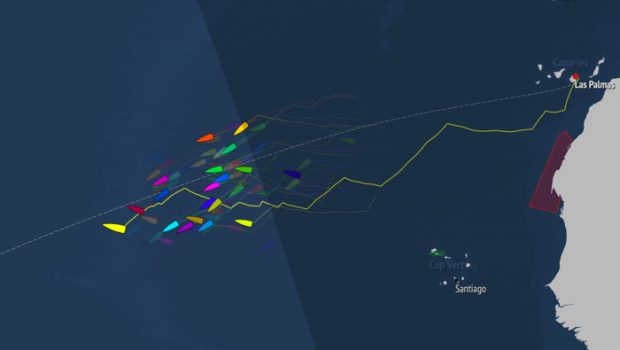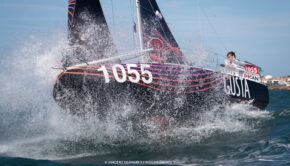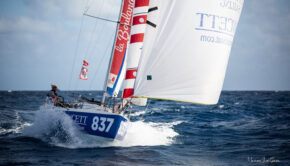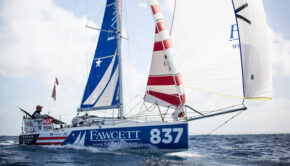Mini Transat: Growing tech issues
Published on November 9th, 2019
(November 9, 2019; Leg 2; Day 8) – One week ago, the 82 Mini 6.50 solo sailors, in the Mini-Transat La Boulangère 2019 set sail on the second leg from Las Palmas de Gran Canaria to Le Marin in Martinique. This evening, the leaders in the prototype (François Jambou) and production fleets (Ambrogio Beccaria) are a little over 1,000 miles from the goal and, according to the latest routing, may well make the finish line November 14 after just 12 days of racing. Behind them, the list of technical issues is growing.
It all began just one week ago to the day. After a long stopover in Las Palmas de Gran Canaria, 82 solo sailors set sail on the second leg of the Mini-Transat La Boulangère with an unshakeable desire to get going and finally experience this much-awaited passage.
The first few minutes set the tone, with some skippers caught off guard. Since then, the pace has been very steady with a well-established trade wind. The sailors and their gear bear the scars. This evening, a violent wind is sweeping across the fleet once again with 28 to 35 knots of breeze and a building sea.
Two sailors have been sailing at a reduced pace today. The support boat O’kayam is sailing alongside Joe Lacey (963) this evening. We don’t yet know the nature of the damage suffered aboard the British sailor’s boat but in any case various people have rallied around him and he’s safe.
Also in difficulty today, Marie-Amélie Lénaerts (833) spent all day trying to effect repairs and has now picked up speed again and was making 6.8 knots at the 16:00 UTC position report. She has been escorted by Frédéric Bach (533), who has shown true solidarity during this time, putting his own race to one side to support a fellow sailor.
Following a series of discussions via VHF with various racers, the support boat Yemanja has a variety of damage to report today, as explained in their message sent from on-board: “Fedor Druzhinin (759) is having to heave to in order to carry out some repairs. He’ll tell us when he’s setting sail again so don’t be surprised to see him stopped on the tracker.
“Julien Berthélémé (742) suffered a dark series of events last night after a major wipe-out in a squall, breaking his boom, though he has since repaired that with splints, and he ended up with a torn mainsail, a spinnaker in tatters and a twisted pulpit. He’s continuing on his way. Albert Lagneaux (882) has broken his rudder link bar but was able to replace it and he has another spare one.”
There is also news today from Antoine Perrin (850), who after a fantastic start to the race (4th place after four days of racing) has tumbled back down the prototype ranking after breaking his bowsprit ball joint. The latter ball joint has fallen overboard and is therefore impossible to repair. Antoine also laments rudder issues but these remain manageable.
From the various scenarios above, it is clear to see that the sailors who are experiencing material damage face some dilemmas right now: Is a repair possible at sea? Is it better to make a pit stop, at the risk of losing a lot of time? Since leaving Las Palmas de Gran Canaria, four competitors have made a stopover: Amélie Grassi (944), Marie Gendron (930), Jean Lorre (570) and the latest, Matteo Sericano (888), who arrived in Mindelo, Cape Verde, yesterday.
Fortunately the Italian skipper has since set sail again having repaired his damaged rudder. Meantime Marco Buonanni (769), has decided that he can make Le Marin with a single working rudder, while Bastian Ogier (740) is also continuing on his way despite some kind of rudder issue. Either way, the skippers are certainly running out of options now for stopovers.
So how are the first production boats managing to compete with the top prototypes? In the prototype category, François Jambou (865) retains a solid lead over Axel Tréhin (945) who, given the speeds racked up of late, appears to have repaired his damaged spinnaker. Astern, Erwan Le Méné (800) has moved up into 3rd place today to the detriment of Tanguy Bouroullec (969). The stellar performance posted by rookie sailor Morten Bogacki (934) from Germany should be applauded, the latter completing the Top 5, less than 25 miles shy of Tanguy Bouroullec (16:00 UTC position report).
In the production boat category, Ambrogio Beccaria (943) is still masterfully leading the way and is also 2nd overall! Meantime his pursuers, Nicolas d’Estais (905), Benjamin Ferré (902), Pierre Le Roy (925), Félix de Navacelle (916) and Lauris Noslier (893) are ahead of the 3rd prototype! “It’s impressive to see the production boats in such a good position”, comments Tanguy Leglatin, coach to the skippers at the Lorient Grand Large training hub.
“That means that there’s been more breeze than forecast on the grib files. In the breeze, the production boats are easier to manage, you can really push them hard without asking yourself too many questions about your gear. On a prototype, you’re forced to ease off the pace in these conditions as the boats are more fragile. We experienced a similar scenario in the Mini-Transat 2009, where Francisco Lobato came close to taking the outright win in the first leg.”
Ranking on Saturday, November 9 at 16:00 UTC
PROTOTYPE
1- François Jambou (865 – Team BFR Marée Haute Jaune) 1,114.9 miles from the finish
2- Axel Tréhin (945 – Project Rescue Ocean) 86.6 miles behind the leader
3- Erwan Le Méné (800) Rousseau Clôtures Tanguy Bouroullec (969 – Cerfrance) 159.4 miles behind the leader
PRODUCTION
1- Ambrogio Beccaria (943 – Geomag) 1,162.8 miles from the finish
2- Nicolas D’Estais (905 – Cheminant – Ursuit) 57.2 miles behind the leader
3- Benjamin Ferré (902 – Imago Incubateur D’aventures 57.3 miles behind the leader
Event details – Entry list – Tracker – Facebook
The biennial Mini-Transat La Boulangère has competition for the Mini 6.50 Class in two divisions: the prototypes and the production boats.
Production boats are built out of fiberglass, have alloy masts, 1.6 meter draft, and prohibit material such as titanium, carbon fiber, and epoxy resin. Ten boats must have been built to qualify as an official production boat.
Prototypes, on their side, are free of these restrictions and have been, for years, the very first laboratory for sailing innovations. Canting keels, daggerboards, swinging wing masts, long poles for huge spinnakers, have been tried first on minis. New hull shapes with very wide waterlines and foils are the now the latest innovations.
Race Format:
Eighty-seven started the first leg on October 5 (delayed from September 22 due to storms) from La Rochelle, France and extends 1350 nm to Las Palmas de Gran Canaria. After an often complicated exit of the Bay of Biscay, sailors will expect some long slips down the Portuguese coast before arriving after 7 to 10 days in the Canary archipelago.
Eighty-two started the second leg on November 2 from Las Palmas de Gran Canaria and will take from 15 to 20 sailing days to complete the 2700 nm course and reach Le Marin in Martinique, French West Indies. Due to the numerous islands, the restart from the Canary can be tricky before reaching the famous trade winds that offer a long downwind run.
Source: Effetsmer










 We’ll keep your information safe.
We’ll keep your information safe.